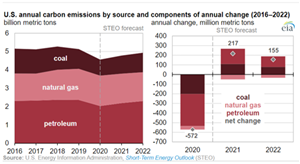U.S. projects climbing energy-related CO2 emissions in 2021 and 2022
WASHINGTON - In its January 2021 Short-Term Energy Outlook (STEO), the U.S. Energy Information Administration (EIA) expects that energy-related carbon dioxide (CO2) emissions in the United States will increase in 2021. Economic growth and the lessening of pandemic-related restrictions result in more energy consumption and associated CO2 emissions. EIA expects total energy-related CO2 emissions to increase to 4.8 billion metric tons in 2021 and 4.9 billion metric tons in 2022.
U.S. energy-related CO2 emissions fell by an estimated 11% in 2020, largely because of reduced travel and other factors that have led to less energy consumption during the COVID-19 pandemic. In the short term, EIA forecasts rising CO2 emissions as a result of economic recovery from the COVID-19 pandemic, changes in fuel mix, and greater demand for residential electricity as colder winter weather leads to more heating demand in 2021.
EIA expects petroleum to account for about 46% of total U.S. energy-related CO2 emissions in 2021 and 47% of total energy-related CO2 emissions in 2022. Most of these emissions come from the transportation sector as a result of increased travel as the economy recovers from the effects of the COVID-19 pandemic.
EIA expects natural gas, which accounted for about 36% of total energy-related CO2 emissions in 2020, to decline to about 34% of total emissions in 2021. Emissions from natural gas are declining mainly because natural gas consumption is declining as natural gas prices increase relative to coal prices. EIA expects natural gas prices to increase by 98 cents per million British thermal units (MMBtu) in 2021 while prices for coal increase by 12 cents/MMBtu. As a result, EIA forecasts that natural gas’s share of total energy-related CO2 emissions will decline to 32% in 2022 as natural gas prices rise.
Coal accounted for 19% of total U.S. energy-related CO2 emissions in 2020. EIA expects this share of total emissions to rise to 21% in 2021 and 2022 as coal becomes more economical for use in electricity generation amid higher natural gas prices.
More information on EIA’s forecasts is available in the January Short-Term Energy Outlook.



